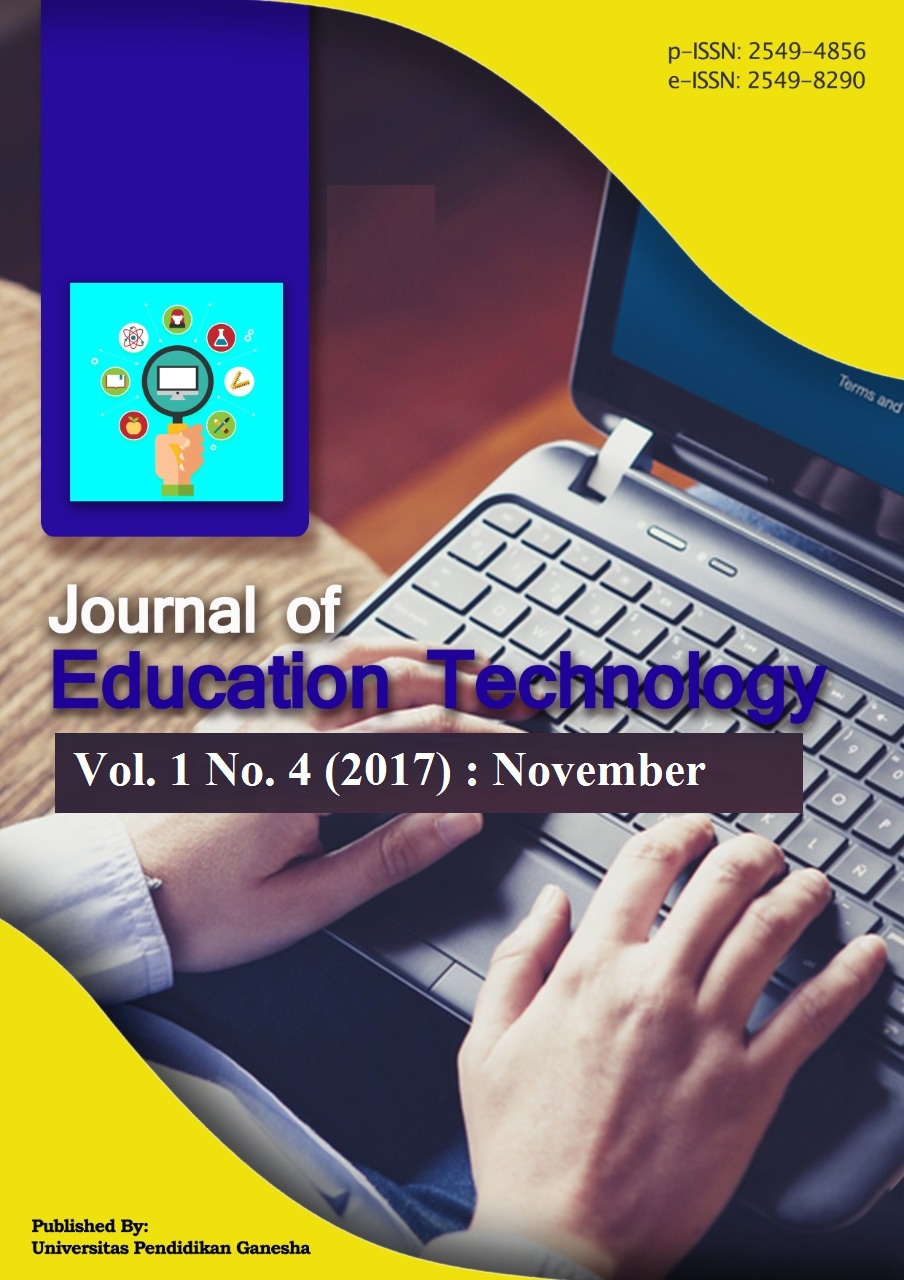PENERAPAN PERSON CENTERED THERAPY DI SEKOLAH (EMPATHY, CONGRUENCE, UNCONDITIONAL POSITIVE REGARD) DALAM MANAJEMEN KELAS
DOI:
https://doi.org/10.23887/jet.v1i4.12862Keywords:
Person centered therapy, empathy, congruence, unconditional positive regardAbstract
Artikel ini membahas Person centered therapy dibidang konseling, untuk membantu dalam proses hubungan, empathy, congruence, unconditional positive regard, sebagai konsep penting pendekatan tersebut dan sebagai saran terhadap manajemen kelas. Merupakan hal yang penting jika proses belajar-mengajar berpusat pada siswa, sehingga pertimbangan siswa akan berpusat pada segala hal yang berhubungan dengan pendidikan. Ketika siswa menjadi bagian dari suatu keputusan maka siswa akan merasa ikut berperan dan bertanggung jawab. Dalam person centered therapy mungkin tidak menawarkan solusi yang siap jadi atau mengarahkan klien untuk mengikuti strategi mengatasi masalah tertentu. Apa yang terapis lakukan adalah menggunakan kesempatan dalam hubungan kepercayaan melalui penghargaan terhadap klien sehingga masalah yang dihadapi dapat diselesaikan. Secara keseluruhan, klien diasumsikan dapat memiliki kemampuan untuk membuat solusi atas permasalahannya, dan terapis hanya bertindak sebagai teman dalam proses penyembuhan.
References
Barnard, D. (1984). The personal meaning of illness: Client-centred dimension of medicine and health care. Cited in P. T. Clarke (2004), A person-centred approach to stress management. British Journal of Guidance & Counselling
Carkhuff, R. R. (1969a). Beyond counseling and therapy. Cited in E. L. Tudor, K. Keemar, T. Keith, J. Valentine, & M. Worrall, M. (2004). The person-centred approac. A contemporary introduction. Basingstoke: Palgrave Macmillan
Carkhuff, R. R. (1969b). The art of helping. Cited in E. L. Tudor, K. Keemar, T. Keith, J. Valentine, & M. Worrall (2004). The person-centred approach. A contemporary introduction. Basingstoke: Palgrave Macmillan.
Clarke, P. T. (1994). A person-centred approach to stress management. British Journal of Guidance & Counselling
Corey, G. 2009. Theory and Practice: Counseling and Psychotherapy. Belmont CA: Brooks/Cole Cengage Learning
Dryden, W. (1990). Rational-emotive counseling in action. Cited in E. L. Tudor, K. Keemar, T. Keith, J. Valentine, & M. Worrall (2004). The person-centred approach. A contemporary introduction. Basingstoke: Palgrave Macmillan
Egan, G. (1990). The skilled helper: A systematic approach to effective helping. Brookes/Cole publishing company
Fox, M. (1993). Psychological perspectives in education. London: Cassell Education Limited
Hill, J. (1994). Person-centred approaches in schools. Manchester: Manchester Pccs books
Liestaer, G. (1984). Unconditional positive regard: A controversial basic attitude in client centred therapy. Cited in P. T. Clarke (1994). A person-centred approach to stress management. British Journal of Guidance & Counselling, 22
Mearns, D., & Thorne, B. (1988). Person-centred counseling in action. Cited in P. T. Clarke (1994). A person-centred approach to stress management. British Journal of Guidance & Counselling
Nelson, J. R. (2000). Practical counselling skills. Mumbai: Better you books
Patterson, C. H. (1980). Theories of counseling and psychotherapy. Cited in P. T. Clarke (1994). A person-centred approach to stress management. British Journal of Guidance & Counselling
Thorne, B. (1984). Person-centred therapy. Cited in P. T. Clarke (1994). A person-centred approach to stress management. British Journal of Guidance & Counselling
Tudor, E. L., Keith, T., Valentine, J., Worrall, M. (2004). The person-centred approach. A contemporary introduction. Palgrave Macmillan
Downloads
Published
How to Cite
Issue
Section
License
Authors who publish with the Journal of Education Technology agree to the following terms:
- Authors retain copyright and grant the journal the right of first publication with the work simultaneously licensed under a Creative Commons Attribution License (CC BY-SA 4.0) that allows others to share the work with an acknowledgment of the work's authorship and initial publication in this journal.
- Authors are able to enter into separate, additional contractual arrangements for the non-exclusive distribution of the journal's published version of the work (e.g., post it to an institutional repository or publish it in a book), with an acknowledgment of its initial publication in this journal.
- Authors are permitted and encouraged to post their work online (e.g., in institutional repositories or on their website) prior to and during the submission process, as it can lead to productive exchanges, as well as earlier and greater citation of published work. (See The Effect of Open Access)


















